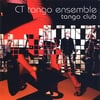Años de soledad (Years of Solitude) by Astor Piazzolla, performed live by the CT Tango Ensemble at the Paulaner October Music Festival 2008 held at the V & A Waterfront in Cape Town, South Africa.
Stanislav Angelov – Accordion
Albert Combrink – Piano
Jacek Domagala – Violin
Dave Ridgeway – Double Bass
Werner Denner – Saxophone
Frank Mallows – Drums
Live recording produced by Marek Pinksy from CDXpress.
The track is also recorded on the CD TANGO CLUB– with a slightly different line-up which includes Drummer Kevin Gibson, Double-Bassist Charles Lazar and Cape Town Saxhophone Master Willie van Zyl, whose wonderful tone is always thrilling to listen to.
To buy the CD TANGO CLUB or book the musicians, E-Mail Albert Combrink or contact our record label Good Music World. The CD is also on sale internationally – and for PM3 Download – at CDbaby.com
****
MORE ABOUT THE SONG:
Años de soledad (Years of Solitude) by Astor Piazzolla
Astor Piazzolla composed this piece in 1974 for himself to perform with the great Jazz Saxophonist Jerry Mulligan (1927-1996). It was recorded on their album Summit- Reunion Cumbre. Due to the influence of Mulligan, this work, and in fact the entire disc, is more oriented towards Jazz than Tango, and reflects the experiments Piazzolla was making with taking the Tango in the 70s. Piazzolla is said not to have enjoyed the process of recording the album – two strong-minded individuals each famous in their own genre were bound to have their difficult moments. He did however have a long-standing admiration for Mulligan and his particular take on Jazz. .
As a performer I have a different relationship with this piece as perhaps a dancer would. Whenever we perform this work in a dance-context, people are happy to dance to it – the piece was conceived with a drummer in mind – as after the dramatic improvisations and flourishes of the opening, it pretty much ticks along to the end, building to an exciting climax. If anything, this work reminds me of the large symphonically conceived creations of French Tango Accordionist Richard Galliano, such as the glorious Tango Pour Claude. The Baritone sax and the Accordion compliment each other beautifully, primarily as the instruments both have a vocal quality.





Leave A Comment
You must be logged in to post a comment.